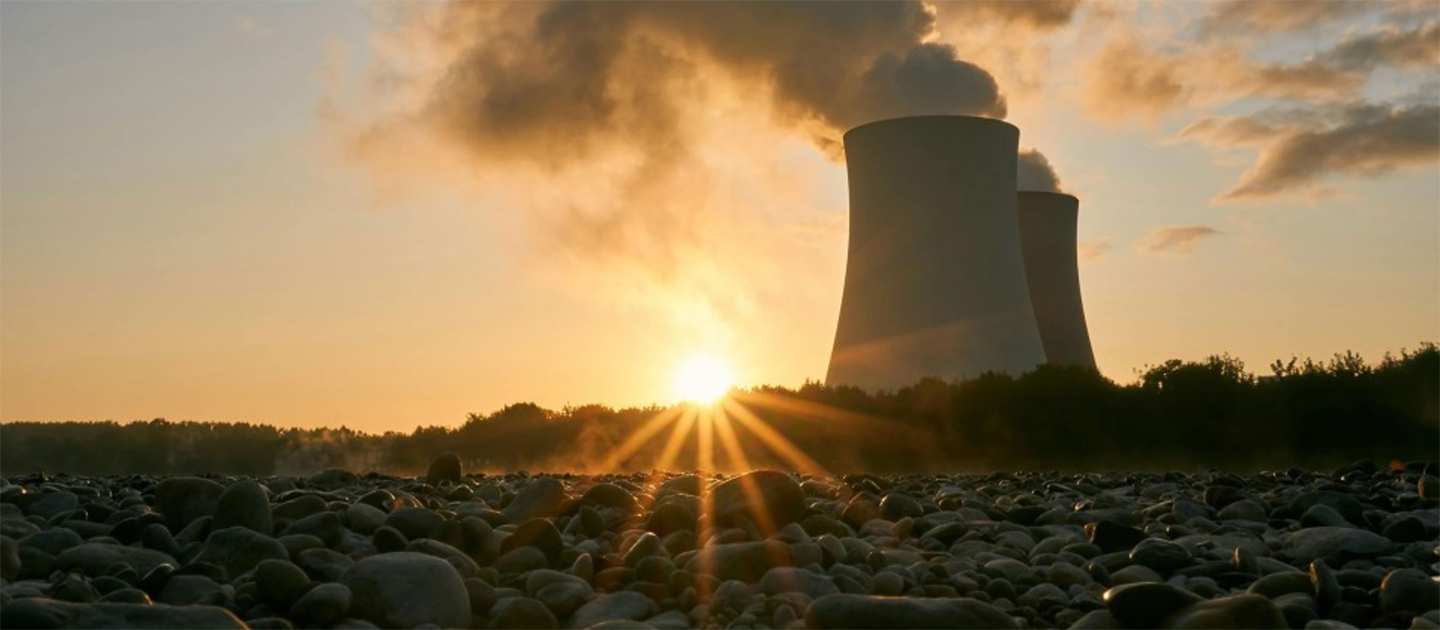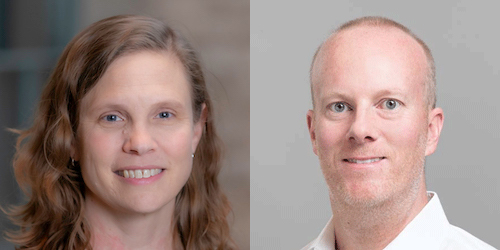Northwestern to Lead Midwestern Carbon-Capture Hub
Project receives nearly $4 million to test feasibility of direct air capture technologies

Recognizing that carbon dioxide (CO2) removal is a critical tool for thwarting the worst of climate change impacts, the U.S. Department of Energy (DOE) has dedicated billions of dollars to explore the potential of direct air capture (DAC) technologies that can pull CO2 out of the atmosphere.

Regional DAC Hubs are a key part of DOE’s strategy and are supported with $100 million in DOE investments. Northwestern University is leading one of these hubs with nearly $4 million invested by DOE and partner companies. The award will be administered through the Paula M. Trienens Institute for Sustainability and Energy.
The DOE-funded projects will work to demonstrate the capture, processing, delivery and sequestration or end-use plans for captured carbon. Called the Midwest Nuclear DAC Hub (MINDAC), the Northwestern-led program will unite a diverse group of research and commercial partner institutions to test the feasibility of using a zero-emission nuclear fleet to power air handling units that remove CO2 from the atmosphere.
MINDAC, which officially started on May 1, is one of only two DAC hubs located in the Midwest as well as one of two hubs with plans to harness nuclear energy as a power source.
Funded by the historic Bipartisan Infrastructure Bill and the Inflation Reduction Act, the Regional DAC Hubs Program will accelerate the demonstration and deployment of DAC technologies, supporting efforts to create jobs, reduce pollution and reinforce the United States’ global competitiveness in clean energy technologies.
After feasibility testing and engineering are complete, together these Hubs are expected to capture 1 million metric tonnes of CO2 annually from the atmosphere. This is 250 times more CO2 than the largest operating DAC facility currently removes.
“While we need to amplify efforts to reduce greenhouse gas emissions across all economic sectors, given the urgency and severity of climate change we need all options on the table — full speed ahead,” said Northwestern Engineering’s Jennifer Dunn, the principal investigator of the project. “These options include direct air capture. We are excited to work with all our MINDAC partners and the Department of Energy to build a viable carbon capture hub in our region.”
While we need to amplify efforts to reduce greenhouse gas emissions across all economic sectors, given the urgency and severity of climate change we need all options on the table — full speed ahead.
Jennifer DunnProfessor of Chemical and Biological Engineering
An expert on the environmental impacts of emerging technologies, Dunn is a professor of chemical and biological engineering at the McCormick School of Engineering, director of the Center for Engineering Sustainability and Resilience, and a faculty affiliate of the Trienens Institute.
MINDAC’s co-principal investigators are: Ted Sargent, the Lynn Hopton Davis and Greg Davis Professor of Chemistry at Northwestern’s Weinberg College of Arts and Sciences, a professor of electrical and computer engineering at McCormick, and co-executive director of the Trienens Institute; Omar Farha, the Charles E. and Emma H. Morrison Professor of Chemistry at Weinberg and (by courtesy) professor of chemical and biological engineering; and Brad Sageman, a professor of Earth and planetary sciences at Weinberg and co-director of the Trienens Institute. Mar Reguant, a professor of economics at Weinberg, will serve as a senior adviser. Ke Xie, a research assistant professor in Sargent’s laboratory, will serve as the Hub’s project manager.
“This initiative will make an important contribution as we develop solutions to tackle the global challenge of climate change,” Sargent said. “The issue requires diverse solutions — ones that can be used in combination with one another — and this includes direct air capture. As one of the world’s leading universities in engineering, materials science, chemistry, and the social sciences, Northwestern will bring unparalleled expertise to this vital initiative.”
From intensifying storms to declining biodiversity to rising sea levels, the tragic effects of worsening climate change are becoming more visible each year. According to the United Nations, emissions need to decrease by 45 percent by 2030 in order to limit climate change to 1.5 degrees Celsius. Simply decreasing the volume of emissions is not enough. To hit this critical target, scientists estimate that billions of tons of CO2 also must be removed from the atmosphere.
DAC technologies can reduce this lingering legacy CO2 by literally pulling it out of the air. The CO2 then can be safely and permanently stored deep underground or upcycled into valuable products, contributing to a circular carbon economy.
“The Illinois Basin has a number of deep rock formations with favorable properties for CO2 storage,” Sageman said. “And successful CO2 sequestration already has been demonstrated in the basin.”
For multiple reasons, the Midwest is uniquely positioned as an ideal location for a DAC Hub. Home to industry and high-traffic roadways, the Midwest region is a large emitter of CO2 in the United States. As a consequence of climate change, the region is subject to extreme temperature and precipitation fluctuations — with cold air masses from the far north converging with warm, humid air masses from the Gulf of Mexico.
The issue requires diverse solutions — ones that can be used in combination with one another — and this includes direct air capture. As one of the world’s leading universities in engineering, materials science, chemistry, and the social sciences, Northwestern will bring unparalleled expertise to this vital initiative.
Ted SargentLynn Hopton Davis and Greg Davis Professor of Chemistry, Weinberg College of Arts and Sciences; Professor of Electrical and Computer Engineering
According to the U.S. Energy Information Administration, Illinois also has the most nuclear power of any state in the nation, making nuclear energy an attractive and reliable zero-carbon energy source to power the capture process. Nuclear energy facilities also produce abundant waste heat, which can be integrated into capture facilities to further reduce energy costs.
“Incorporating CO2 captured from air into building materials or plastics can sequester carbon,” Dunn said. “Alternatively, processes can convert captured CO2 into fuels that can replace energy from fossil fuels. When the processes that capture CO2 use nuclear power, the potential for carbon neutral or carbon negative products and fuels arises, which is very exciting.”
MINDAC’s feasibility study will develop a model to integrate carbon capture technologies, manufacturing at scale, CO2 utilization, and CO2 transportation and geological sequestration. To unify expertise in nuclear energy, DAC technologies, site development and manufacturing, Northwestern has partnered with a host of major research and industrial partners including Argonne National Laboratory, Constellation, Siemens, 3M, Energy Capital Ventures, LanzaTech, RepAir, and Avnos.
Each partner will bring a specialized contribution to the team. Global leaders in DAC technologies, RepAir and Avnos will test the carbon capture and carbon removal systems. With the largest nuclear fleet in the nation, Constellation will explore the viability of its clean energy centers to supply carbon-free nuclear power to the MINDAC Hub. LanzaTech, a carbon capture and use company that uses synthetic biology to convert waste carbon into materials and higher-value products, will explore uses for the captured carbon.
“RepAir Carbon's electrochemical technology operates solely on electricity, without the need for heat, enabling ultra-low energy consumption,” said Amir Shiner, CEO of RepAir. “Today, as direct air capture requires a baseload, low-carbon power source, RepAir emerges as an ideal solution for integration with nuclear power supply. We are honored to be included in Northwestern's DAC hub and to be collaborating with such strong companies.”
Northwestern has a long legacy of leading DOE hubs and being at the forefront of carbon capture research. The newly launched Midwest Alliance for Clean Hydrogen (MachH2) serves as the most recent example, with Dunn as the project’s chief decarbonization officer. Farha also leads one of nine projects selected by the DOE to study carbon capture systems. His team studies metal-organic frameworks, porous materials with uniform structures that are promising solid sorbents – a sponge of sorts for capturing CO2 from air.
“Finding ways to remove and store carbon directly from the air is an absolute necessity in our fight against the climate crisis,” Secretary of Energy Jennifer M. Granholm said. “This investment in carbon capture technology research through universities and DOE laboratories will position America as a leader in this growing field, create good-paying jobs, and help make our carbon-free future a reality.”